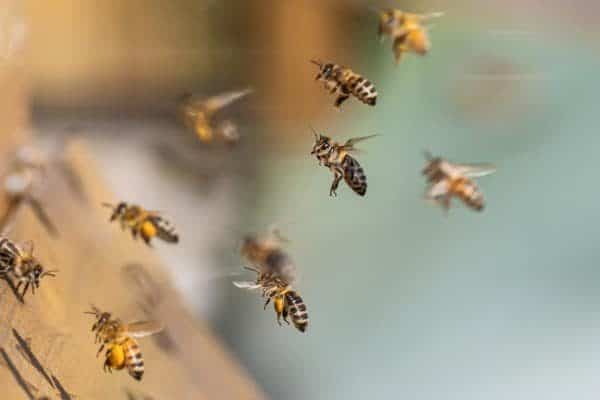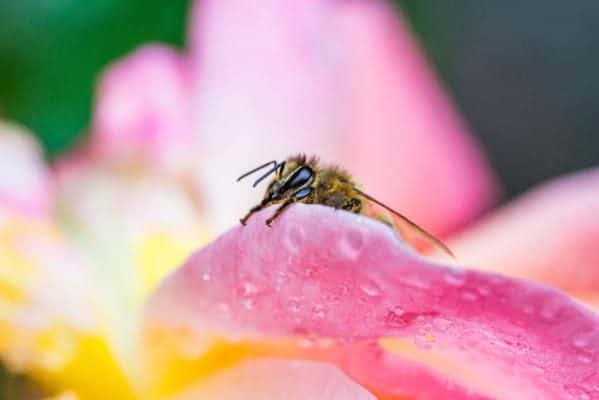
This is an interesting question and one that also intrigued scientists for a long time. Bees need to fly miles a day and on return trips to the hive, they are traveling with a heavy payload of nectar and pollen. So how do bees fly with so much weight on board?
How Do Bee Fly? Bees use a unique wing action to fly. Bees’ wings are small compared with other insects of similar body size, weight, and payload capacity. To fly so well bees have 4 wings that flap at 230 beats per second. The key to their flying ability is that bees’ wings rotate on each stroke giving them extra lift.
Bees should not be able to fly. The 70 year mystery.
In 1934, August Magnan and André Sainte-Lague after using conventional aerodynamic theory they suggested after mathematical analysis of the bees wings and body size that is should be impossible for bees to fly let alone carry a payload of nectar and pollen that almost doubles their body weight.
Clearly bees can fly very well. This also demonstrates that bees are most certainly not bound by conventional aerodynamic theory. This left scientists scratching their heads for about 70 years.
In 2005 technology stepped in to help solve the decades-long mystery. Scientists were able to utilize high-speed digital video. They used three synchronized cameras placed orthogonally capturing 3 to 5 second bursts of footage at 6000 frames per second.
This technology enabled the scientists to slow down the bees 230 wingbeats per second to a speed that revealed previously unknown details as to how a bee’s wings can produce the lift required.
The secret of how bees fly
It was discovered that there are three elements that work together perfectly to deliver the lift and control required to make bees flying specialists.
Those elements are:
1. Wingbeat Frequency
Most insects use an increase in wingbeat frequency in order to generate additional power for lift. Bees, however, maintain a fairly consistent wingbeat of about 230 beats per second. The frequency remains steady (within about 2%) whether the bee is hovering above their first flower of the day or flying back to the hive with a full load. The high wingbeat frequency is the blur that hid the answer to how bees fly.
2. Wing Rotation
What was discovered was that bees rotate their wings at each end of each stroke. This rotation provides a significant additional lift.
3. Wing Amplitude
Wing amplitude is the degrees of movement the bees wings move through during flight. During a hovering maneuver, the wing amplitude of a bee is only about 90 degrees. Bees adjust the amplitude of their wings according to the lift that they need. All the time maintaining wingbeat frequency.
It is the return from foraging when carrying almost their body weight in pollen and nectar that they will extend the wing amplitude out to as much as 140 degrees.
How high do bees fly?
This can really be a twofold question. How high can bees fly and how high do bees choose to fly?
When answering this question we need to take a step back and remember bees are specialists in order and efficiency. With that in mind, bees will only fly as high as they need to in order to reach the pollen and nectar they are tasked with collecting.
If they are scouting or foraging for pollen and nectar the altitude they are flying at can increase as they fly through hills and mountains however they really have no need to go more than a few hundred feet off the ground.
Bees have the ability however to work at high altitudes where the air is thin. Like helicopters, their ability to produce lift drops off with the thinning air at high altitudes. This means bees can not carry as heavy payloads of pollen and nectar. This drop-in efficiency means more trips are required by forager bees to gather the same amount of pollen and nectar as bees at living at a lower altitude.
In high altitude areas you will often see mountains with snow-capped peaks. This highlights another issue for bee living at altitude. At high altitudes, the seasonal temperatures are much cooler than seasonal temperatures at lower altitudes in the same geographical area.
This means that sources of nectar and pollen could be for example limited to only 4 months of the year with possibility bees will need to fly long distances to lower altitudes to find resources. In this example, they need to store enough food to last for 8 months. With very long and cold periods, beekeepers will need to ensure the hives are well insulated and well supplemented with food.
All that being said there are beekeepers operating at as high as 8000 feet. Apiaries at this altitude require significant supplemented feeding during the long cold months.
Interestingly bumblebees have the ability to not only fly at very high altitudes but they have been discovered nesting on Mt Everest at 18,400 ft (5,608 Meters). In a compression chamber, tests have revealed that bumblebees are capable of flying to a simulated height of 30,000 ft (9,144 Meters).
Check out the video below that compares this amazing high flying talent to other insects’ ability to fly high.
How fast can bees fly?
Bees can fly up to 20 Mph (32 Kph) in good weather conditions without a payload of nectar and pollen. As the bees age, their wing condition deteriorates which can affect their flight speed.
When loaded with nectar and pollen, now almost double their body weight, the speed in good weather conditions will drop to about 12 Mph ( 19.2 Kph).
It is the bee’s flight muscles that are driving their wings. Do you know that bees are able to deliver oxygen directly to these flight muscles? We look at how they are able to do this in another article, Do Bees Have Lungs?
How long can a bee fly for?
This is a difficult question to answer for certain. There are a number of factors to consider and the data varies in regards to distance. Studies have suggested that bees will fly up to 5km (3.125 miles) from the hive meaning a 10km (6.25 mile) round trip returning with a load of pollen and nectar.
A beekeeper in Australia who is hired to pollinate sunflower plantations with block sizes of 15km (9.375 miles) X 15km (9.375 miles) claims to have observed bees at the center of the plantation meaning they are completing to 15km round trip to gather pollen from sunflowers in the middle.
What we do know is that bees are very efficient. In reality, this means that bees will only fly as far as they need to find good sources of pollen and nectar.
There are three reasons why efficiency is so important to the bees:
1. Trips Per Day
The shorter the trip to a source, the more nectar, and pollen each bee can collect in a day. This is important particularly in areas where the warm times of the year are short.
2. Energy for flight
When bees are foraging they use a lot of energy. This is replenished from the nectar they are collecting. So the longer the flight the more nectar is used and therefore the amount left to contribute to the hive is reduced.
3. Life expectancy
The worker bees inevitably die from worn-out wings. The average life expectancy of a worker honey bee during a honey flow is about 6 weeks. Typically the last 3 weeks of their life is spent foraging for pollen and nectar.
The long flight times carrying heavy payloads of pollen and nectar cause their wings to become frayed until they can no longer function properly. Other factors that can result in the premature death of foraging worker bees include sudden changes of weather, predatory birds, and insecticides.
Do bees fly in the rain?

Bees can handle flying in light rain however bees will not fly in heavier rain. Bees, for the most part, do not get caught out in bad weather.
We do have an entire article related to this on bumblebees, Can Bumblebees Fly in the Rain?
Studies have indicated that bees have the ability to detect changes in temperature, humidity, solar radiation, wind conditions, and barometric pressure. Changes in these environmental conditions give bees indicators to predict potential incoming weather threats.
These threats trigger a defensive response within the bees and the hive. Forager bees will return from the field to the hive for protection. Studies have also shown that in the days before a weather event the number of bees foraging and the length of time during the day that they are in the field increases. This is because the bees are increasing the stores of pollen and nectar as they may be confined to their hive until the weather passes.
So bees will avoid flying in the rain, however, the impending rain will increase the number of bees flying and the time they are flying in the days leading up to a rain event.
